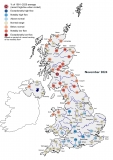Submitted by Michael Eastman on
October was, for much of the month, typical for mid-autumn: mild (1.4 °C above the 1981 - 2010 average) but largely unsettled, with some dry and warm periods punctuating the showery spells. The final ten days, however, saw persistent and heavy rainfall, especially across northwest Britain in the final week, which resulted in notable monthly totals and attendant river flow responses. The synoptic situation was similar to recent major flood events (principally, November 2009 and December 2015), with an ‘atmospheric river’ bringing a persistent stream of moisture from the subtropics to the hills of western Britain. While long-duration rainfall totals were comparable, the flow response was less exceptional due to the drier antecedent conditions, although some locally severe flood impacts occurred. The October rainfall wetted soils across much of the country and, in stark contrast to September, river flows for October were significantly above average across western areas and most of southern England. Similarly, groundwater levels increased in many boreholes and were above normal across most aquifers, particularly so in parts of the Chalk. Reservoir stocks increased sharply, from exceptionally low September levels in many cases. Stocks were slightly above average for England & Wales, but below average in a few impoundments in drier areas of central England (e.g. Derwent Valley) and in Northern Ireland and parts of Scotland. Overall, water resources were healthy entering November and the focus was on elevated flood risk, with Outlooks suggesting a continuation of above normal river flows and groundwater levels.



